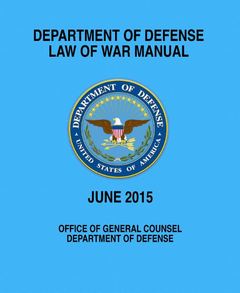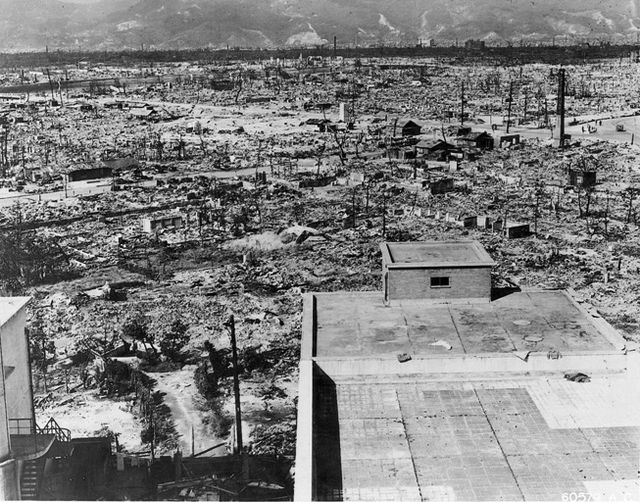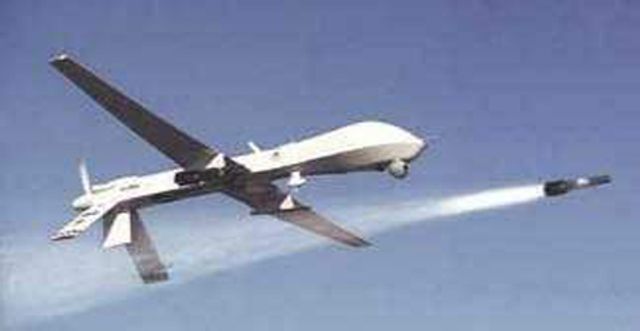
PART ONE | PART TWO | PART THREE | PART FOUR
This is the third of four articles analyzing the new US Department of Defense Law of War Manual.
The Department of Defense (DOD) Law of War Manual represents the most advanced ideological expression of the striving of US imperialism to dominate and control the entire world by means of military force.
By authorizing the Pentagon to occupy, wage war against and impose its own version of “law” in every corner of the planet, the DOD manual merely formalizes the world-hegemonic agenda of US imperialism and points to its logical endpoint.
“US capitalism is up against the same problems that pushed Germany in 1914 on the path of war. The world is divided? It must be redivided. For Germany it was a question of ‘organizing Europe.’ The United States must ‘organize’ the world. History is bringing humanity face to face with the volcanic eruption of American imperialism.” This was written by the founder of the Fourth International, Leon Trotsky, in 1934.
From the mid-1970s onward, the US ruling class has engaged in a relentless militarization drive aimed at overcoming through armed force its economic decline.
This was also foreseen by Trotsky, who wrote:
“In the period of crisis the hegemony of the United States will operate more completely, more openly and more ruthlessly than in the period of boom. The United States will seek to overcome and extricate herself from her difficulties and maladies primarily at the expense of Europe, regardless of whether this occurs in Asia, Canada, South America, Australia, or Europe itself, or whether this takes place peacefully or through war.”
The Law of War Manual, which elaborates protocols for military operations in every corner of the globe by the Pentagon and its proxy forces, amounts to a manifesto for this process, set down in legal jargon. If the guidelines laid out in the manual are allowed to be implemented—that is, if the international working class does not intervene in time on the basis of a revolutionary program—then humankind faces a future dominated by concentration camps, slaughter on an unprecedented scale, and, ultimately, a nuclear holocaust.
In essence, the DOD manual represents a comprehensive statement of the only “solution” to the world crisis that the imperialist cliques in Washington and on Wall Street are capable of offering.
Total war
The first two articles in this series have drawn the parallels between the Department of Defense Law of War Manual and the legal and political ideology of Nazi Germany. It has been shown that the very same fascist conceptions rejected by leading American jurists at the Nuremberg trials have, in the form of the DOD manual, been codified as official state policy at the highest levels of the American government.
Later sections of the DOD manual, those covering the practices of US military operations, make clear that the scorched earth methods employed by the Nazis against the populations of Europe, the Soviet Union and North Africa are now embraced and defended by the Pentagon high command.
The manual overturns central tenets of international law designed to place restraints on the use of military violence. On the basis of the Oxford English Dictionary definition of total war as “a war that is unrestricted in terms of the weapons used, the territory or combatants involved, or the objectives pursued, especially one in which the laws of war are disregarded,” one can state without hesitation that total war has become the central policy of the DOD.
Every form of military activity conventionally associated with total war—a concept that emerged during the 19th century before finding its consummate expression in the mayhem and destruction perpetrated by both the fascist and “democratic” imperialist governments during the Second World War—is explicitly or implicitly allowed by the Pentagon guidelines.
Every nominal restriction on the DOD’s war-making powers included in the manual is accompanied by caveats that confer virtually unlimited discretion on US military commanders to employ violence in the service of US strategic aims. The manual carefully avoids any language that might discourage commanders from planning offensive operations. There are gaping loopholes in every section designed to instill confidence that there will be no penalty for the indiscriminate use of force.
The manual authorizes US commanders to engage in strategic bombing, attacks on civilian commercial infrastructure, blockades and sieges. It authorizes the establishment of mass detention and forced labor camps.

Hiroshima in 1945
Of course, throughout its history, US imperialism has committed horrific violations of international laws along these lines, carrying out collective punishment, mass slaughter of populations, and the destruction of urban areas in Germany, Japan, Korea, Vietnam, Cambodia and, most recently, Iraq.
The military campaign launched against Iraq in 2003 reduced one of the most advanced economies in the Middle East to a level of social development comparable to that of the poorest countries in the world. Some 4-5 million Iraqis were killed, displaced or disappeared as a result of the US war and occupation. More than half of Iraqi doctors were killed or forced to flee the country. Reports published in 2007 by Iraq’s Statistical Bureau showed that, four years after the war was launched, fully 43 percent of Iraqis were living in “absolute poverty,” without reliable access to food, housing or clothing.
Prior to the release of the DOD manual this year, however, the US high command employed such methods in defiance of its own regulations, which still included clearly worded prohibitions against wanton destruction of civilian infrastructure and populations. The last comprehensive document on military law issued by the US Department of Defense, the 1956 US Army Field Manual on the Law of Land Warfare, still maintained that military operations could not be launched if it was known in advance that they would lead to large-scale civilian casualties.
While including formal prohibitions against the slaughter of civilians similar to those contained in the 1956 document, the new manual provides conceptual loopholes based on notions of “military necessity,” “expected military advantage,” etc.
The publication of the DOD manual is thus enormously significant as an official assertion by the US ruling elite of its “right” to demolish entire societies and peoples in pursuit of its political goals. Undoubtedly, the DOD manual was crafted with an eye toward legalizing, after the fact, the crimes committed against Iraq by US imperialism.
Under the manual’s guidelines, direct mass killing of civilians is effectively legalized, so long as the relevant US military officers consider that attacks around or against civilian targets are weighed “in relation to the concrete and direct military advantage expected to be gained.” (P. 187)

Predator drone firing a Hellcat missle
Commanders are authorized to conduct operations that they know will lead to large numbers of civilian deaths, as long as their subjective assessment finds that such operations contribute to “the broader imperatives of winning the war.” This applies even when the “military advantage” to be gained from a proposed attack could not be understood by an “outside observer,” i.e., on the basis of any objective or universal criteria.
“The military advantage expected to be gained from an attack might not be readily apparent to the enemy or to outside observers because, for example, the expected military advantage might depend on the commander’s strategy or assessments of classified information,” the manual states. (P. 213)
“The weighing or comparison between the expected incidental harm and the expected military advantage does not necessarily lend itself to empirical analyses,” the document adds. (P. 128)
“In less clear-cut cases, the question of whether the expected incidental harm is excessive may be a highly open-ended legal inquiry, and the answer may be subjective and imprecise,” the manual declares. (P. 245)
In defining what constitutes a legitimate military target, DOD employs a definition that is so broad as to encompass the entire economy and civilian population of enemy states. The manual authorizes destruction of basic infrastructure, including housing stock, power generation facilities, water facilities, and food supply chains of enemy states. Any object that contributes to the “war-fighting capacity” of the enemy nation, even in an indirect manner, is declared by the manual to be a legitimate target. (P. 206)
“The term ‘military objective’ means combatants and those objects during hostilities which, by their nature, location, purpose, or use, effectively contribute to the war-fighting or war-sustaining capability of an opposing force,” the manual reads.
It is not necessary that the object provide immediate tactical or operational gains or that the object make an effective contribution to a specific military operation. Rather, the object’s effective contribution to the war-fighting or war-sustaining capability of an opposing force is sufficient… The advantage need not be immediate. (P. 210)
The law of war does not require that attacks on a military objective be conducted near ongoing fighting, in a theater of active military operations, or in a theater of active armed conflict. (P. 199)
In a critique of the target selection practices called for by the manual, entitled “The Defense Department Stands Alone on Target Selection,” Professor Adil Haque of the Rutgers School of Law-Newark notes that the manual effectively authorizes US commanders to carry out attacks regardless of the civilian death toll that is likely to result.
“A deeply troubling provision in the Defense Department’s new Law of War Manual suggests that commanders are not legally required to minimize civilian casualties when selecting between different targets,” Haque writes. “The United States is not legally required to select targets so as to reduce collateral harm to civilians.”
Large sections of the manual are devoted to siege, enforced starvation and occupation of densely populated urban areas. It authorizes the erection of ghettos and security cordons to restrict the movement of civilians.
“Starvation is a legitimate method of warfare,” the DOD manual states. (P. 291) “In particular, it is permissible to seek to starve enemy forces into submission.”
During siege warfare, US military commanders are authorized, among other things, to destroy supply lines that are relied on by the civilian population for food and other essential goods. “States may institute general food control programs that involve the destruction of crops and the adequate provision of the civilian population with food,” the manual reads in the section entitled “Starvation of Enemy Forces Not Prohibited.” (P. 1,037)
It advises US officers to allow passage of “certain categories of civilians,” implying that much of the civilian population can be left for dead inside the encircled area. Commanders are authorized to completely isolate urban areas, refusing the movement of even the most basic humanitarian goods into the siege zone.
“A commander of an encircling force is not required to agree to the passage of medical or religious personnel, supplies, and equipment,” the manual states. (P. 316)
The implications of this doctrine were already demonstrated in the US military’s 2004 siege of Fallujah in Iraq. Tens of thousands of Iraqi men between the ages of 15 and 55 were prevented from fleeing the city prior to a devastating US bombardment that destroyed some 60 percent of the city’s buildings, irradiated the entire area with toxic munitions byproducts, and permanently reduced the population by as much as 50 percent.
The manual authorizes the use of illegal weapons, another practice commonly understood as a feature of total war, including cluster bombs and nuclear weapons, against a range of “military objectives,” including “mountain passes, hills, defiles, and bridgeheads, villages, towns, or cities” whose seizure is militarily important. (P. 215)
“Under certain circumstances, it may be advantageous to use cluster munitions,” the document reads. “The United States has determined that its national security interests cannot be fully ensured consistent with the terms of the Convention on Cluster Munitions.”
Employing a formula that becomes all too familiar to any reader of the manual, the document openly authorizes use of nuclear weapons based on calculations of “military advantage.”
“Attacks using nuclear weapons must not be conducted when the expected incidental harm to civilians is excessive compared to the military advantage expected to be gained,” the document states. (P. 420)
Such formulations amount to a green light to do anything. Would the DOD high command consider the destruction of China’s key military and economic infrastructure to be militarily advantageous? Of course, and therefore nuclear attacks would be justified.
In fact, the DOD’s Air Sea battle plan envisions a crushing first strike against the Chinese mainland, using a level of force so overwhelming as to prevent any possibility of retaliation by the Chinese military.
Mass detention and concentration camps
Brushing aside democratic legal principles that have been developed over centuries, the manual asserts the absolute power of the US military-security apparatus to detain civilians anywhere on the planet. “Detention is fundamental to waging war or conducting other military operations,” the Pentagon lawyers assert in the opening lines of the section “Detention: Overview and Baseline Rules.” (P. 515)

Prisoners in the Sachsenhausen concentration camp, 1938
While the executive branch has already asserted similar prerogatives with the passage of the National Defense Authorization Act of 2012, it remains significant that the DOD now openly maintains its own sweeping powers to act as an independent branch of government, exercising essentially limitless authority.
The manual maintains that the Defense Department may re-interpret and negate international agreements that prohibit extra-legal arrests and detentions, upholding the unlimited right of the American national state to nullify well-established international laws.
The DOD lawyers go so far as to cite relevant portions of international law that directly contradict their own positions before sweeping them aside as incompatible with the US government’s interpretations.
“Anyone who is deprived of his liberty by arrest or detention shall be entitled to take proceedings before a court, in order that that court may decide without delay on the lawfulness of his detention and order his release if the detention is not lawful,” a passage from the International Covenant on Civil and Political Rights (ICCPR), reprinted in the manual, states. (P. 50f)
The document then declares that the US government has “understood” such prohibitions not to apply to its own policies. As far as DOD and the US government are concerned, the manual makes clear, the content of international laws is determined by the way in which such laws are re-understood by top US military attorneys and bureaucrats.
“For example, the right to challenge the lawfulness of an arrest before a court provided in Article 9 of the International Covenant on Civil and Political Rights (ICCPR) would appear to conflict with the authority under the law of war to detain certain persons without judicial process or criminal charge,” the manual reads.
However, the United States has understood Article 9 of the ICCPR not to affect a State’s authorities under the law of war, including a State’s authority in both international and non-international armed conflicts to detain enemy combatants until the end of hostilities. (P. 50)
The manual goes on to outline authorizations for DOD to create specific legal instruments in order to overcome any remaining legal obstacles to its detention powers, allowing for the creation of “Ad Hoc Legal Instruments or Frameworks” and “Special Courts.”
According to the manual, “Detaining Powers” may segregate detainees in prison camps based on racial and ethnic criteria. “Detainees may be segregated into camps or camp compounds according to their nationality, language, and customs, and the Detaining Power may use other criteria to segregate detainees for administrative, security, intelligence, medical, or law enforcement purposes.” (P. 498)
US military authorities are empowered to carry out mass resettlement of populations for “imperative military reasons.” Under the heading “Displacement of the Civilian Population,” the manual states: “The Occupying Power may undertake total or partial evacuation of a given area if required for the security of the population or for imperative military reasons.” (P. 778)
And further: “The displacement of the civilian population shall not be ordered for reasons related to the conflict unless the security of the civilians involved or imperative military reasons so demand.” (P. 1,035)
Martial law and occupation
The manual outlines procedures for military occupation and imposition of martial law on subjugated territories. Protocols are formulated in extremely general terms, making clear that the entire world, including the US “Homeland,” is viewed as actual or potential Occupied Territory.
Inhabitants of territory under US military rule must submit unconditionally to the dictates of the “Occupying Power,” rendering “strict obedience to the orders of the occupant,” the manual states in the section “Suspension and Substitution of Governmental Authority.”
US commanders may “exercise authority over all means of public and private transportation, whether land, waterborne, or air, within the occupied territory, and may seize them and regulate their operation,” the manual asserts.
Lest there be any illusions that protocols for military occupation and suspension of constitutional government do not apply within the borders of the United States, the manual announces that the DOD-promulgated law of war policies are being integrated into US domestic law. “Law of war requirements have also been incorporated into domestic law, policy, regulations, and orders,” the document states (P. 1,057).
In the section on “Non-International Armed Conflict,” the manual develops another conceptual loophole that enables US forces to violate the Geneva Conventions and other international laws when engaged in operations against persons or organizations that are not formally part of an internationally recognized state.
Whereas the manual assigns some limited relevance to international laws in relation to military conflicts against rival national states, non-international armed conflicts are said to be conducted under the essentially limitless authorities assigned by the manual to the US government as the world’s most powerful national state.
Non-state actors cannot claim the legal status of national governments and are essentially considered to be legally naked, that is, fully at the mercy of the US government and not entitled to the minimal protections afforded to captured enemy POWs.
The sovereign equality of States is not applicable in armed conflicts between a State and a non-State armed group. A State may exercise both sovereign and belligerent rights over non-State armed groups. (P. 1,025)
The limits imposed by international law on a State’s action against non-State armed groups do not alter the basic principle that the State may exercise its sovereign powers against the non-State armed group…
Although, during international armed conflict, lawful combatants are afforded certain immunities from the enemy State’s jurisdiction, persons belonging to non-State armed groups lack any legal privilege or immunity from prosecution by a State that is engaged in hostilities against that group. (P. 1,025)
Such language serves to put US officers on notice that, in confronting insurrectionary movements by the American and international working class, they are permitted to cast aside all restraints conventionally associated with the law of war as it has evolved over centuries.
Source Article from http://www.globalresearch.ca/the-pentagons-law-of-war-manual-total-war-and-the-ideology-of-imperialism/5498951
Views: 0
 RSS Feed
RSS Feed















 January 9th, 2016
January 9th, 2016  Awake Goy
Awake Goy 
 Posted in
Posted in  Tags:
Tags: 
















